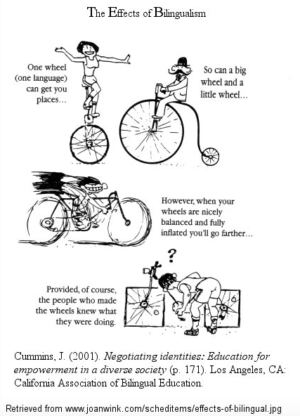
If you are a parent reader of this article, you may well be already convinced that being bilingual, and even plurilingual, is an asset. However, you might sometimes wonder how to best support your children on their journey to becoming effective speakers, as well as proficient readers and writers, in their respective languages. Biliteracy is the ability to read and write in two languages. Since children at the Lycée Français de New York receive formal reading and writing instruction in French and English, they are considered to be biliterate. There is ample evidence confirming that successful bilingual readers and writers view their dominant language, often their first language, as an asset while learning in another and actively transfer skills, strategies, and knowledge.
Described below are ways in which you can help bilingual children to capitalize on their unique linguistic and cultural profile while acquiring literacy skills. First and foremost, as a parent, you are a role model and coach.
1 Develop a Growth Mindset
Mindset and learning go hand in hand. Carol Dweck, author of Mindset: The New Psychology of Success, defines two types of attitudes towards intelligence and ability: a growth mindset vs. a fixed mindset. Her research reveals that those who view challenges as opportunities to grow rather than potential failure are more likely to succeed.
Those with a fixed mindset hold the belief that their intelligence, abilities, and talents are set and cannot be changed. In a fixed mindset, a person believes they are either good at something, or they are not. Likewise, those with a fixed mindset might view their errors as proof of their inadequacies. In the face of difficulty, they might give up easily.
On the contrary, people who have a growth mindset believe that their abilities can be developed. These people are more likely to succeed because they:
- recognize that effort is essential for growth.
- regard their mistakes as an opportunity to learn.
- are less affected by failure.
Plurilingual students benefit from a growth mindset. They often find themselves in situations that highlight their developing proficiency in one language or another. Indeed, children who speak two, three, or even four languages are sometimes confronted with challenges. For instance, they might be faced with an unfamiliar word or expression that requires them to put forth extra effort. With the right mindset, they are more likely to take on the challenge.
It is essential to cultivate a growth mindset at home. Be aware of your own mindset toward learning to ensure that you are setting a positive example. Compliment your child when you notice efforts during challenging moments. Stress that perseverance can lead to success. Furthermore, when parents make it clear that mistakes are opportunities to learn, children integrate this as a natural part of the learning process.
2 Encourage Metacognition:
Help your child to drive their brain. Metacognition—the awareness and regulation of one’s thought processes—can be explained as “driving your brain” to success. Donna Wilson and Marcus Conyers, two experts in brain-based teaching, explain the positive impact metacognitive skills have on learning. Children who are aware of their thought processes can identify when comprehension breaks down and attempt to fix it. As your child becomes comfortable identifying his or her difficulties, you can equip him or her with problem-solving strategies. This leads to greater confidence, independence, and an increase in motivation.
Challenge, but don’t rescue. Imagine you are a soccer coach. Your job is to teach the players to be strategic. For example, the soccer coach doesn’t kick the ball in the net for each player. Rather, the coach teaches the players a set of skills and strategies to employ based on possible situations during a game. You can do the same for children as they read and write. Try coaching your child to use specific strategies to problem-solve. For example, if your child asks you what a word means while reading, instead of giving the definition, ask them to take a guess. You can prompt your child to go back and reread the sentence or section where the word appears and use clues from the text to guess its meaning. Help your child to work through the problem rather than save him or her from the necessary effort required to succeed.
Below is a list of possible prompts that you can use while your child, specifically while reading, to encourage metacognition:
Identifying the problem:
What do you understand so far?
When/why did you become confused?
Are you stuck on a word?
Solving the problem:
Did you back up and reread?
Can you create a mental picture as you read?
Do you need to keep reading to get more information?
Did you use clues from the story to help you figure out the word/phrase/part? Think about what would make sense.
Does this unfamiliar word look like a word from another language you know?
In conclusion, metacognitive readers knows:
- what they do not understand.
- why they do not understand.
- how to improve their comprehension using specific strategies.
3 Encourage Transfer Across Languages:
Jim Cummins, a leader in bilingual education, has proven that there are many opportunities to transfer knowledge and skills between languages. Languages are simply vehicles for learning. What is learned in one language does not need to be learned again in the other. Though some children transfer naturally, it is often necessary to explicitly teach children to transfer for two reasons: 1) It allows them to be aware of the common skills between the languages, and 2) it gives them the confidence to transfer that knowledge when necessary. According to Cummins, different types of transfer are possible:
- Metacognitive skills that help to monitor and control understanding
- Content and conceptual knowledge, such as understanding electricity
- Reading skills and strategies, such as decoding, summarizing, and visualizing a text
- Linguistic knowledge, such as parts of speech, similar letter sounds, and vocabulary
Consistency is key. Use every opportunity to encourage your child to leverage their bilingualism. Emphasize that learning multiple languages is an advantage. Children with a growth mindset and metacognitive skills are more likely to effectively transfer from one language to the other. Do not hesitate to use your dominant language when helping your child. If your child is familiar with these ideas in one language, they have the ability to transfer to others.
About the Author :
Mylène, who is French, and Carolyn, who is American, have been teachers in the Lycée’s Primary School for over 10 years. Passionate educators with a deep interest in the impact of bilingualism on cognition and learning, they received a co-teaching research grant this year to explore literacy in bilingual learners. As part of their grant, they hosted a series of workshops this past year for Lycée parents interested in learning how to support bilingual learners at home.


